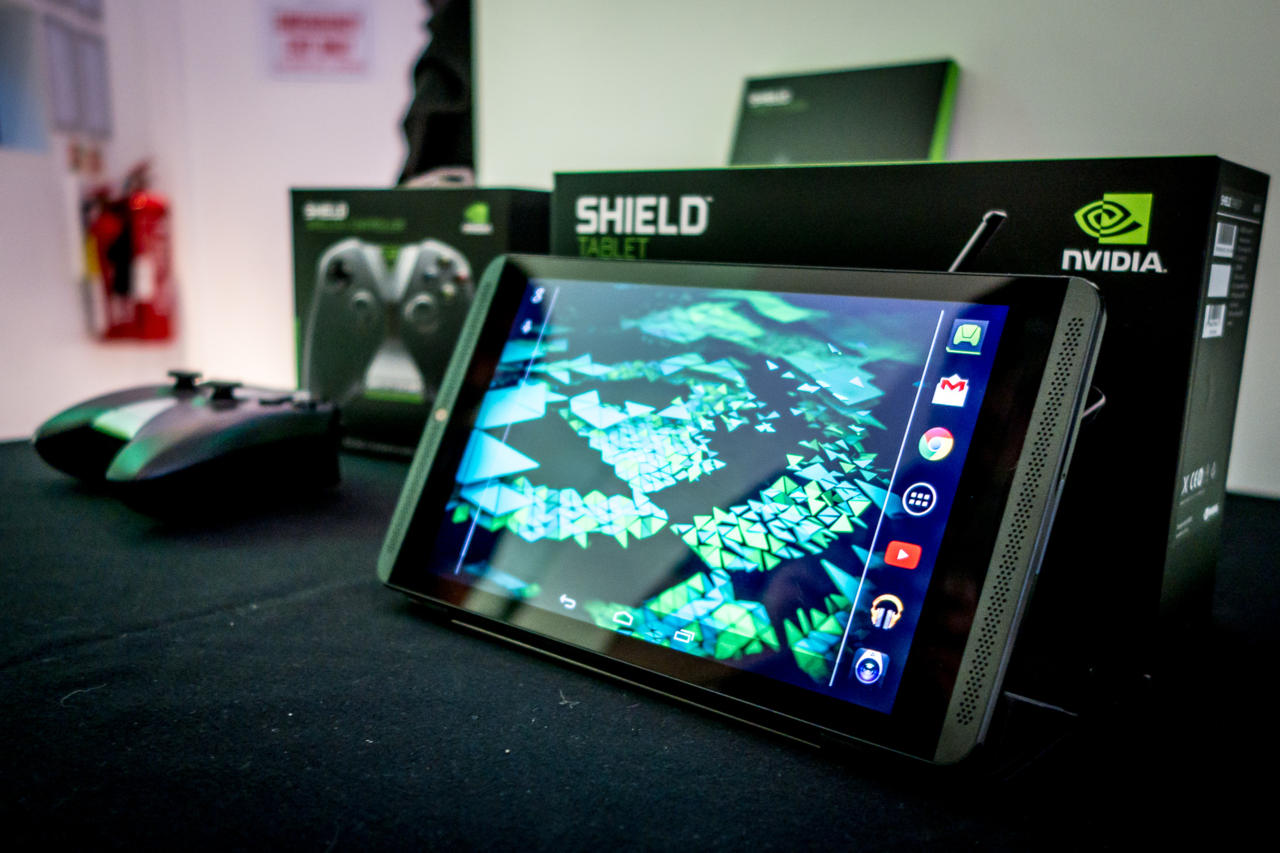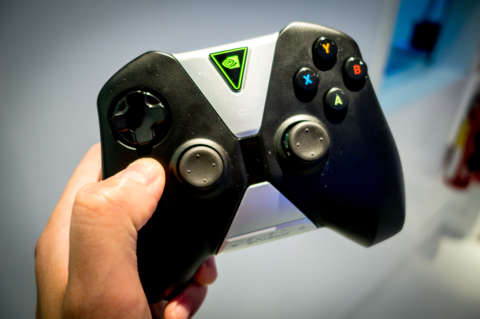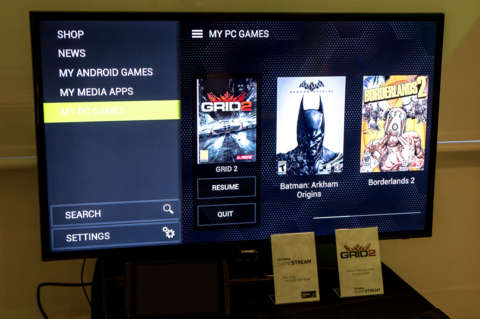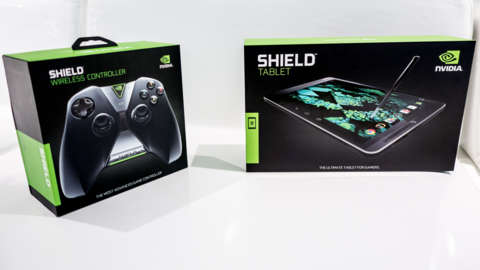Nvidia's Shield Tablet Makes a Good First Impression, Not So Sure About the Controller
Ooh, shiny.
GPU maker Nvidia is expanding its Shield line of handheld Android gaming devices. Where the first Shield was a quirky mash-up of gaming controller and LCD screen, its follow-up is far more reserved. The Shield Tablet (starting at $299/£229 for a 16GB Wi-Fi model) is an 8-inch tablet that at first glance looks like a standard black slate with a glass screen. Its gaming focus comes from its 32-bit Tegra K1 internals, a separate wireless controller that will retail for $59, and a $39 cover with kickstand. While there's a certain inconvenience with having to carry around a separate controller to play non-touch games, it's a preferable compromise when the alternative is something like the gargantuan Wikipad.

While I'm still waiting to get some more time with the Shield Tablet for a full review, I was pleasantly surprised after my brief hands-on with the device. The tablet itself is understated, with a matte black finish and front-facing speaker grills reminiscent of HTC's One series of mobile phones; the only branding comes from an embossed Shield logo on the back. The top of the tablet houses a headphone jack, a micro USB port, and a mini HDMI 1.4a port, while around the side is a slot for a sim card on LTE models ($399 with 32GB of memory), a slot for micro SD expansion up to 128GB, and a slot for the stylus that makes use of Nvidia's DirectStylus 2 technology.


The bulk of the tablet is dominated by a clear and bright 1920x1200-pixel LCD screen up front. While the bezel seems a little chunky by today's standards, the Shield Tablet is a pleasing device to look at, and with a 9.2mm thickness and a 390g weight, it's comfortable to hold too. Indeed, it's not hard to imagine people picking up a Shield Tablet, simply because it's a good tablet. And--for UK consumers at least--the price isn't that large a markup over the £199 Nexus 7. Nvidia is planning on hooking people in with the Shield Tablet's gaming credentials, though, and for that you get a powerful 32-bit Tegra K1 (used to great effect with Unreal Engine 4 at Google's IO conference), as well as a bunch of gaming-focused software that sits atop a largely stock build of Android 4.4.3.
Most notable is the tablet's Twitch integration, which lets you stream almost any app, game, or part of the Android interface. The front-facing camera is used for picture-in-picture, while audio commentary comes from the integrated microphone, controller microphone, or an external headset. The feature worked well in the demo I was shown, but I'm not sure we'll start to see people Twitch streaming and commentating on their games from coffee shops (or, at least I hope we don't!) as Nvidia envisages. When plugged into a TV, the tablet automatically switches into console mode, which brings up a controller-optimised 1080p interface for launching and purchasing apps and games. Essentially, you get simple text for menus, and big images to select the games or apps you want to use. It wasn't fancy, but it worked just fine on a big TV.
Like the Shield handheld, the Shield Tablet supports Nvidia's GameStream tech, which lets you stream games from your home PC to the tablet. Over Ethernet, games are streamed in 1080p, while Wi-Fi or LTE limits that to 720p. I had a quick blast on Dirt 2, and while the visuals looked impressive, there was a slight pause between my actions on the controller and the car's movement on screen. It'll be interesting to see how well the feature works at home, but Nvidia has said it hasn't made any large improvements to the existing GameStream tech, so if you're already using it with a Shield handheld, the experience will be largely the same.
Similarly, if you've used a Shield handheld, the separate $59 controller will be familiar to you too, which is to say, it's rather big. The Shield handheld's size is forgivable given it houses a full Android device within, but it's tough to see why the Shield controller is so large. It's not original-Xbox-controller large, but even for someone like me with large hands, it didn't feel as comfortable as, say, an Xbox One or PlayStation 4 controller. Aside from a mushy D-pad (seriously, why is it so hard to make a good D-pad?), though, the controller was otherwise decent, and the Android buttons at the top and the touchpad at the bottom for navigating mouse-driven menus in PC games were useful additions during the demo.
The controller also has a built-in microphone, which Nvidia was keen to show working with Google Now so you can bark "OK Google" commands at your TV while the tablet is in console mode. It can also be used for voice chat in games, but there's also a headphone jack on the bottom of the controller for using a separate headset if you prefer. Interestingly, the controller works via a proprietary Wi-Fi standard instead of Bluetooth, which Nvidia claims results in 2X less latency.
Up to four Shield controllers can be used with the tablet, but it also supports regular Bluetooth controllers if you prefer. If you're wondering whether you can use the Shield controller with your other Android devices, sadly, that's not a feature that's going to be available at launch. Nvidia says it's working with Google to integrate the specialised drivers into Android so other devices can make use of the controller, but has not confirmed a date. Support for the controller is coming to the existing Shield Portable via a software update, though.

Sadly, there were a bunch of other features on the Shield Tablet I didn't get to check out, including 1080p Netflix streaming, Hulu Plus, a 3D drawing app for use with the stylus, and ShadowPlay for capturing gameplay footage. I also didn't get much time with many games, but Nvidia is promising that 11 Tegra K1-optimised games will be available at launch, including Trine 2 (which comes free with every device), Half Life 2, and the free-to-play shooter War Thunder, complete with cross-platform online play.
I'll be checking those games out, as well as giving the Shield Tablet the full review treatment just before launch, so keep your eyes on GameSpot for more soon.
Got a news tip or want to contact us directly? Email news@gamespot.com










Join the conversation